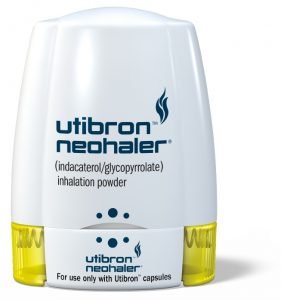Utibron Neohaler Inhalant Dispenser Now Available in US for COPD
Written by |

U.S. pharmacies have begun carrying the Utibron Neohaler treatment-dispensing device as a long-term maintenance treatment for airflow obstruction in chronic obstructive pulmonary disease (COPD), Sunovion Pharmaceuticals announced.
The powder that the device dispenses, which is a combination of indacaterol and glycopyrrolate, is aimed at preventing bronchospasms in people with COPD. It works by relaxing the muscles in the airways to improve breathing. The powder is not a rescue medication, however: It will not work fast enough to treat a sudden bronchospasm attack or acute COPD symptoms.
Glycopyrrolate is a long-acting muscarinic antagonist (LAMA) bronchodilator, and indacaterol is a long-acting beta2-agonist (LABA) bronchodilator.
LABAs and LAMAs are widely used therapies. They dilate the airways in the lungs to reduce symptoms like wheezing, cough, chest tightness and shortness of breath. Combining LABAs and LAMAs may offer added benefits, including increased effectiveness, compared with using one of them as a stand-alone therapy.
“Utibron Neohaler is well aligned with the recently updated global treatment strategy for COPD, which emphasizes the use of a LAMA/LABA combination for maintenance treatment in the majority of symptomatic COPD patients,” Gary Ferguson, MD, of the Pulmonary Research Institute of Southeast Michigan, said in a press release.
Glycopyrrolate works by inhibiting receptors responsible for bronchoconstriction. Indacaterol stimulates the adenyl cyclase enzyme in lung muscle cells. The enzyme helps increase levels of cyclic adenosine monophosphate (cAMP), which inhibits the release of substances that can trigger hypersensitivity.
Clinical trials have shown that the Utibron Neohaler’s powder improves lung function compared with either of its bronchodilator components alone. On average, the two trials showed, it took 12 to 16 minutes after the first dose for its effect to kick in, and the effect lasted 12 hours.
The Utibron Neohaler also improved breathlessness, reduced COPD rescue-medication use, and improved quality of life, the trials showed. The powder’s safety profile was similar to its individual components and a placebo in both trials.
Colds and hypertension, or high blood pressure, were the most common side effects.
The Neohaler container, which is small enough to carry in a pocket, bag or purse, has several feedback mechanisms that allow patients to see whether its medicine-containing capsules are empty.
In addition, “the Neohaler device allows patients to visualize whether their dose was administered, giving them the flexibility to inhale any remaining dose not fully administered,” Ferguson said. “The ability to provide dosing feedback is an important feature for patients and their health care providers.”
The U.S. Food and Drug Administration approved the Utibron Neohaler in October 2015. The authorization was based on the results of four clinical trials. The Phase 3 EXPEDITION trial, which covered more than 2,500 COPD patients, consisted of two 12-week studies of the device’s effectiveness. The other trials were FLIGHT1 (NCT01727141), FLIGHT2 (NCT01712516), and a 52-week safety study, FLIGHT3 (NCT01682863).
Regulators have also approved the device for chronic bronchitis and emphysema, but not asthma.
Sunovion and Novartis entered into an exclusive licensing agreement for the commercialization rights to Utibron Neohaler and other therapy candidates in the United States in December of 2016.





